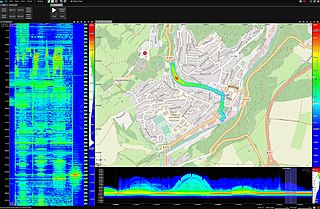
A wireless network is a computer network that uses wireless data connections between network nodes. Wireless networking allows homes, telecommunications networks and business installations to avoid the costly process of introducing cables into a building, or as a connection between various equipment locations. Admin telecommunications networks are generally implemented and administered using radio communication. This implementation takes place at the physical level (layer) of the OSI model network structure.

AT&T Mobility, LLC, also known as AT&T Wireless and marketed as simply AT&T, is an American telecommunications company. It is a wholly owned subsidiary of AT&T Inc. and provides wireless services in the United States. AT&T Mobility is the largest wireless carrier in the United States, with 241.5 million subscribers as of December 31, 2023.
4G is the fourth generation of broadband cellular network technology, succeeding 3G and preceding 5G. A 4G system must provide capabilities defined by ITU in IMT Advanced. Potential and current applications include amended mobile web access, IP telephony, gaming services, high-definition mobile TV, video conferencing, and 3D television.

A cellular network or mobile network is a telecommunications network where the link to and from end nodes is wireless and the network is distributed over land areas called cells, each served by at least one fixed-location transceiver. These base stations provide the cell with the network coverage which can be used for transmission of voice, data, and other types of content. A cell typically uses a different set of frequencies from neighboring cells, to avoid interference and provide guaranteed service quality within each cell.

Orthogonal frequency-division multiple access (OFDMA) is a multi-user version of the popular orthogonal frequency-division multiplexing (OFDM) digital modulation scheme. Multiple access is achieved in OFDMA by assigning subsets of subcarriers to individual users. This allows simultaneous low-data-rate transmission from several users.
Stephen G. "Steve" Perlman is an entrepreneur and inventor of Internet, entertainment, multimedia, consumer electronics and communications technologies and services. He is best known for the development of QuickTime, WebTV, OnLive, pCell and Mova Contour facial capture technologies. In addition to founding startup companies, Perlman was a Microsoft division president and a principal scientist at Apple Computer.

Sri Lanka Telecom PLC, doing business as SLT-MOBITEL, is the national telecommunications services provider in Sri Lanka and one of the country's largest companies with an annual turnover in excess of Rs 40 billion. The company provides domestic and corporate services which include fixed and wireless telephony, Internet access and IT services to domestic, public and business sector customers. As of 2018 SLT-MOBITEL was Sri Lanka's second largest mobile network operator with over 7.9 million subscribers.

RF Drive testing is a method of measuring and assessing the coverage, capacity and Quality of Service (QoS) of a mobile radio network.
Multi-user MIMO (MU-MIMO) is a set of multiple-input and multiple-output (MIMO) technologies for multipath wireless communication, in which multiple users or terminals, each radioing over one or more antennas, communicate with one another. In contrast, single-user MIMO (SU-MIMO) involves a single multi-antenna-equipped user or terminal communicating with precisely one other similarly equipped node. Analogous to how OFDMA adds multiple-access capability to OFDM in the cellular-communications realm, MU-MIMO adds multiple-user capability to MIMO in the wireless realm.
In radio, cooperative multiple-input multiple-output is a technology that can effectively exploit the spatial domain of mobile fading channels to bring significant performance improvements to wireless communication systems. It is also called network MIMO, distributed MIMO, virtual MIMO, and virtual antenna arrays.

In radio, multiple-input and multiple-output (MIMO) is a method for multiplying the capacity of a radio link using multiple transmission and receiving antennas to exploit multipath propagation. MIMO has become an essential element of wireless communication standards including IEEE 802.11n, IEEE 802.11ac, HSPA+ (3G), WiMAX, and Long Term Evolution (LTE). More recently, MIMO has been applied to power-line communication for three-wire installations as part of the ITU G.hn standard and of the HomePlug AV2 specification.
Radio over fiber (RoF) or RF over fiber (RFoF) refers to a technology whereby light is modulated by a radio frequency signal and transmitted over an optical fiber link. Main technical advantages of using fiber optical links are lower transmission losses and reduced sensitivity to noise and electromagnetic interference compared to all-electrical signal transmission.

LTE Advanced is a mobile communication standard and a major enhancement of the Long Term Evolution (LTE) standard. It was formally submitted as a candidate 4G to ITU-T in late 2009 as meeting the requirements of the IMT-Advanced standard, and was standardized by the 3rd Generation Partnership Project (3GPP) in March 2011 as 3GPP Release 10.
International Mobile Telecommunications-Advanced are the requirements issued by the ITU Radiocommunication Sector (ITU-R) of the International Telecommunication Union (ITU) in 2008 for what is marketed as 4G mobile phone and Internet access service.

In telecommunications, 5G is the fifth-generation technology standard for cellular networks, which cellular phone companies began deploying worldwide in 2019, and is the successor to 4G technology that provides connectivity to most current mobile phones.

Small cells are low-powered cellular radio access nodes that operate in spectrum that have a range of 10 meters to a few kilometers. They are base stations with low power consumption and cheap cost. They can provide high data rates by being deployed densely to achieve high spatial spectrum efficiency.
The first smart antennas were developed for military communications and intelligence gathering. The growth of cellular telephone in the 1980s attracted interest in commercial applications. The upgrade to digital radio technology in the mobile phone, indoor wireless network, and satellite broadcasting industries created new opportunities for smart antennas in the 1990s, culminating in the development of the MIMO technology used in 4G wireless networks.
Multiple-input, multiple-output orthogonal frequency-division multiplexing (MIMO-OFDM) is the dominant air interface for 4G and 5G broadband wireless communications. It combines multiple-input, multiple-output (MIMO) technology, which multiplies capacity by transmitting different signals over multiple antennas, and orthogonal frequency-division multiplexing (OFDM), which divides a radio channel into a large number of closely spaced subchannels to provide more reliable communications at high speeds. Research conducted during the mid-1990s showed that while MIMO can be used with other popular air interfaces such as time-division multiple access (TDMA) and code-division multiple access (CDMA), the combination of MIMO and OFDM is most practical at higher data rates.
Citizens Broadband Radio Service (CBRS) is a 150 MHz wide broadcast band of the 3.5 GHz band in the United States. In 2017, the US Federal Communications Commission (FCC) completed a process which began in 2012 to establish rules for commercial use of this band, while reserving parts of the band for the US Federal Government to limit interference with US Navy radar systems and aircraft communications.










